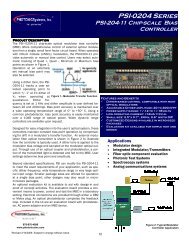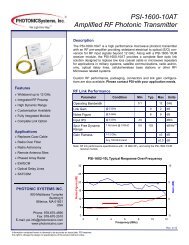2446 JOURNAL OF LIGHTWAVE TECHNOLOGY, VOL. 26, NO. 15, AUGUST 1, 2008Fig. 5. Modeled sources of noise in the link shown in Fig. 4, referred back to thelink input, and measured link noise figure .Key: noise power spectraldensities that appear in the lossless-electrode modulator model (left axis);total noise power spectral density predicted by the lossless model (left axis) andnoise figure predicted by (22) (right axis), which is a repeat of the solid curvein Fig. 2; measured noise figure of link (right axis), also repeated from Fig. 2.Fig. 6. Modeled sources of noise in the link shown in Fig. 4, referred back to thelink input, and measured link noise figure .Key: noise power spectraldensities in the lossy-electrode modulator model that are unchanged from thelossless-electrode model (left axis); noise power spectral densities thatappear only in the lossy model (left axis); total noise power spectraldensity predicted by the lossy model (left axis) and noise figure predicted by(22) (right axis), which is a repeat of the dashed curve in Fig. 2; measurednoise figure of link (right axis), also repeated from Fig. 2.where in both (22) and (23) the link gain with the modulatorbiased degrees away from quadrature bias is(24)Note that for an “ideal” hybrid coupler, and would bothhave a magnitude of and would have opposite sign, sothatwould equal 2, causing (22), (23), and (24) toreduce to (6), (21), and (1), respectively.Figs. 5 and 6 both show the same measured noise figure dataat 1, 2, , 12 GHz for the link in Fig. 4, as were reported in[2] and plotted with a greatly different vertical scale in Fig. 2.The other data plotted in the two figures are the power spectraldensities of the various noise sources in the link, determinedusing the analytical model.In the case of Fig. 5, we calculated all of the noise sourcesshown by the solid curves (the laser , the shot noise arisingfrom the photodetection process, and the thermal noise arisingfrom loss in the hybrid coupler, the resistive termination of themodulator electrodes, and the detector circuit) using our modelas it existed prior to the addition of the effect of loss in the modulatorelectrodes, i.e., using (22). The noise power spectral densitiesare all referred back to the link input by calculating theirmagnitude at the output of the link in dBm/Hz and subtracting.The uppermost curve in Fig. 5 is the total link output noisepower spectral density, which is also referred back to the linkinput by subtracting. According to (2), this totallink output noise referred back to the link input is equal todBm/Hz . Therefore, by adding a right-hand axiswith the same scale and with 0 dB noise figure corresponding toan output noise spectral density of 174 dBm/Hz, this one boldcurve in Fig. 5 is made to represent both quantities, and is thereforethe same as the solid curve in Fig. 2. The measured noisefigure data points plotted in Fig. 5, which are also the same asthose in Fig. 2, likewise correspond to equivalent noise powerspectral densities on the left-hand axis.In Fig. 6, the unlabeled solid curves are unchanged relativeto Fig. 5, but the additional effects of electrode loss, calculatedusing (15) and (20) and individually shown by the labeleddashed curves, are factored into the total shown by the bolddashed curve. Additionally, the “Termination resistance at endof lossy electrodes” curve, calculated using (8), replaces the correspondingcurve in Fig. 5 (“Termination resistance at end oflossless electrodes”), which was calculated using (4).Whereas Figs. 2 and 5 showed considerable discrepancy betweenthe measured data and the lossless model, the analyticalcurves in Figs. 2 and 6 for including the effect ofelectrode loss agree substantially with the same measured data.The slope of the new model’s curve appears to mirror the plotof least-squares fit to the measured data, with a nearly constantdiscrepancy of only 0.4 dB (see Fig. 2). What causesthe improved model to underestimate the measured by thisamount remains under investigation. Now that the discrepanciesbetween modeled and measured are so small, it maybe necessary to re-examine the validity of the general linkexpression derived previously in [1], [6], and [8]. Given the differentstatistical natures of the three types of noise in (2), forexample, we may need to establish the extent to which it is completelyversus only approximately valid to calculate the totalnoise by simply summing the spectral densities of the individualnoise terms. Lastly, further understanding of the model’s remainingshortcomings will be gleaned from comparing modeledand measured of other ultra-low- links using lowmodulatorswith electrodes of other lengths as the demonstrationof such links becomes more commonplace.V. SUMMARY AND CONCLUSIONSWe have hypothesized that thermal noise generated by ohmicloss in the traveling-wave electrodes of an optical intensity mod-Authorized licensed use limited to: Edward Ackerman. Downloaded on October 14, 2008 at 21:32 from IEEE Xplore. Restrictions apply.
ACKERMAN et al.: <strong>RF</strong>-OVER-FIBER LINKS WITH VERY LOW NOISE FIGURE 2447ulator can significantly increase the lower limit to an amplifierlessfiber-optic link’s , and have updated our analyticalmodel to account for this additional effect. We have further interpretedthe substantial agreement shown in Figs. 2 and 6 betweenthe improved model and measured data as experimentalconfirmation of our hypothesis.From this interpretation of the facts we conclude that we mustamend our previous claims as to which photonic device developmentsare necessary for lower amplifierless link . Whereasin [1] we stated simply that lower will require external intensitymodulators with lower , we did not specify in thatpaper how this should be accomplished. The link for whichrecord low was reported in [2] was based on a modulatorin which record low had been achieved by maximizing thelength over which the applied modulation signal acted uponlight in the modulator’s integrated optical waveguides. If thetraveling-wave electrodes supporting this electro-optic interactioncould have been somehow made to be lossless, the analyticalmodels published here and elsewhere predict dBat 1 GHz and 5.0 dB at 12 GHz (as shown by the solid curve inFig. 2). Instead, the loss in those long electrodes dictatedof at least 3.0–6.5 dB across this band. What is requiredfor the lowest possible , therefore, is lower in conjunctionwith lower , implying either lower-loss electrodes (lower) or greater efficiency of modulation over a given interactionlength (i.e., a lower product, such as is being explored inalternative materials such as electro-optic polymers).ACKNOWLEDGMENTThe authors thank Prof. W. B. Bridges of the California Instituteof Technology for helpful conversations.REFERENCES[1] C. Cox, E. Ackerman, G. Betts, and J. Prince, “Limits on the performanceof <strong>RF</strong>-over-fiber links and their impact on device design,” IEEETrans. Microw. Theory Tech., vol. 54, no. 2, pp. 906–920, Feb. 2006.[2] H. Roussell, M. Regan, J. Prince, C. Cox, J. Chen, W. Burns, E. Ackerman,and J. Campbell, “Gain, noise figure, and bandwidth-limited dynamicrange of a low-biased external modulation link,” in Proc. IEEEInt. Topical Meeting Microw. Photon., Victoria, Canada, Oct. 2007, pp.84–87.[3] E. Ackerman, G. Betts, W. Burns, J. Campbell, C. Cox, N. Duan, J.Prince, M. Regan, and H. Roussell, “Signal-to-noise performance oftwo analog photonic links using different noise reduction techniques,”in IEEE MTT-S Int. Microw. Symp. Dig., Honolulu, HI, Jun. 2007, pp.51–54.[4] H. Haus et al., “IRE standards on methods of measuring noise in lineartwoports,” in Proc. IRE, Jan. 1959, vol. 48, pp. 60–68.[5] G. Gopalakrishnan, W. Burns, R. McElhanon, C. Bulmer, and A.Greenblatt, “Performance and modeling of broadband LiNbO travelingwave optical intensity modulators,” J. Lightw. Technol., vol. 12,pp. 1807–1819, Oct. 1994.[6] C. Cox, Analog Optical <strong>Links</strong>. Cambridge, U.K.: Cambridge Univ.Press, 2004.[7] E. Ackerman, G. Betts, W. Burns, J. Prince, M. Regan, H. Roussell,and C. Cox, “<strong>Low</strong> noise figure, wide bandwidth analog optical link,”in Proc. IEEE Int. Topical Meeting Microw. Photon., Seoul, Korea, Oct.2005, pp. 325–328.[8] C. Cox, E. Ackerman, and G. Betts, “Relationship between gain andnoise figure of an optical analog link,” in IEEE MTT-S Int. Microw.Symp. Dig., San Francisco, CA, Jun. 1996, pp. 1551–1554.[9] G. Betts and F. O’Donnell, “Improvements in passive, low-noise-figureoptical links,” in Proc. Photon. Syst. Antenna Applicat. Conf., Monterey,CA, 1993.[10] M. Farwell, W. Chang, and D. Huber, “Increased linear dynamic rangeby low biasing the Mach-Zehnder modulator,” IEEE Photon. Technol.Lett., vol. 5, pp. 779–782, Jul. 1993.[11] E. Ackerman, S. Wanuga, D. Kasemset, A. Daryoush, and N. Samant,“Maximum dynamic range operation of a microwave external modulationfiber-optic link,” IEEE Trans. Microw. Theory Tech., vol. 41, no.8, pp. 1299–1306, Aug. 1993.Edward I. Ackerman (M’87–SM’00–F’07) received the B.S. degree in electricalengineering from Lafayette College, Easton, PA, in 1987, and the M.S.and Ph.D. degrees in electrical engineering from Drexel University, Philadelphia,PA, in 1989 and 1994, respectively.From 1989 through 1994, he was employed as a Microwave <strong>Photonic</strong>s Engineerat Martin Marietta’s Electronics Laboratory in Syracuse, NY, where heused low-loss narrowband impedance matching techniques to demonstrate thefirst amplifierless direct modulation analog optical link with <strong>RF</strong> gain ( 3.7dB at 900 MHz). From 1995 to July 1999, he was a Member of the TechnicalStaff at MIT Lincoln Laboratory, Massachusetts Institute of Technology, Cambridge,where he developed high-performance analog photonic links for microwavecommunications and antenna remoting applications. During this time,he achieved the lowest noise figure ever demonstrated for an amplifierless analogoptical link (2.5 dB at 130 MHz). While at Lincoln Laboratory, he also developedand patented a novel linearization technique that uses a standard lithiumniobate modulator with only one electrode to enable improved analog opticallink dynamic range across broad bandwidths and at higher frequencies thanother linearization techniques currently allow. Currently, he is Vice Presidentof Research and Development for <strong>Photonic</strong> <strong>Systems</strong>, Inc., Billerica, MA. Hehas co-edited a book and has authored or co-authored three book chapters aswell as more than 50 technical papers on the subject of analog photonic subsystemperformance modeling and optimization. He holds two U.S. patents.William K. Burns (M’80–SM’90–F’99) received the B.S. degree in engineeringphysics from Cornell University, Ithaca, NY, and the M.S. and Ph.D.degrees in applied physics from Harvard University, Cambridge, MA.He is currently a Distinguished Staff Member at <strong>Photonic</strong> <strong>Systems</strong>, Inc., Billerica,MA. From 1971 to 1999, he was a Research Physicist with the NavalResearch Laboratory, Washington, DC, where he served as head of the OpticalWaveguide Section of the Optical Techniques Branch. From 1999 to 2004, hewas Chief Scientist at Codeon Corporation and its successor Covega. His researchinterests have primarily been in optical waveguides, lithium niobate integratedoptical devices—including the type of 2 3 optical coupler that PSIwill design for this program—and the application of fiber-optic technology tosignal processing, <strong>RF</strong> photonics, and sensors, in particular the fiber-optic gyroscope.He has authored several book chapters in these areas and edited a bookon fiber optic gyroscopes. He has contributed over 250 papers and presentationsand been granted over 50 patents.Dr. Burns has served on many conference committees, including Optical<strong>Fiber</strong> Communications, Integrated <strong>Photonic</strong>s Research (conference chair in1992), and IEEE LEOS. He was a topical editor for the Journal of the OpticalSociety of America from 1991 to 1994. He received NRL’s Sigma Xi Awardfor Applied Science, and twice received NRL’s Publication Award. In 1996, hewas awarded the Institute of Navigation’s Thurlow Award for contributions tothe fiber optic gyroscope. He is a Fellow of the Optical Society of America.Gary E. Betts (M’84) received the Ph.D. degree in electrical engineering/appliedphysics from the University of California at San Diego in 1985.He is currently a Senior Staff Engineer at <strong>Photonic</strong> <strong>Systems</strong>, Inc., Billerica,MA. His work involves component and system development in the fieldof analog optical links. Prior to joining <strong>Photonic</strong> <strong>Systems</strong>, he was a staffmember at MIT Lincoln Laboratory, Massachusetts Institute of Technology,Cambridge, for 17 years. At MIT he worked primarily on lithium niobateintegrated-optical modulators and analog fiber optic links. His work at MITincluded design and fabrication of linearized modulators, high-frequencymodulators, high-sensitivity modulators, and switch arrays; investigation ofdrift phenomena in lithium niobate; and research on semiconductor modulatorsand high powered semiconductor optical amplifiers. During the fiber opticboom and bust of 2000–2003, he co-founded a modulator company and servedas its vice-president for a portion of its brief life. During his career he hasauthored or co-authored over 70 papers in integrated and fiber optics. He alsoholds five patents.Authorized licensed use limited to: Edward Ackerman. Downloaded on October 14, 2008 at 21:32 from IEEE Xplore. Restrictions apply.




